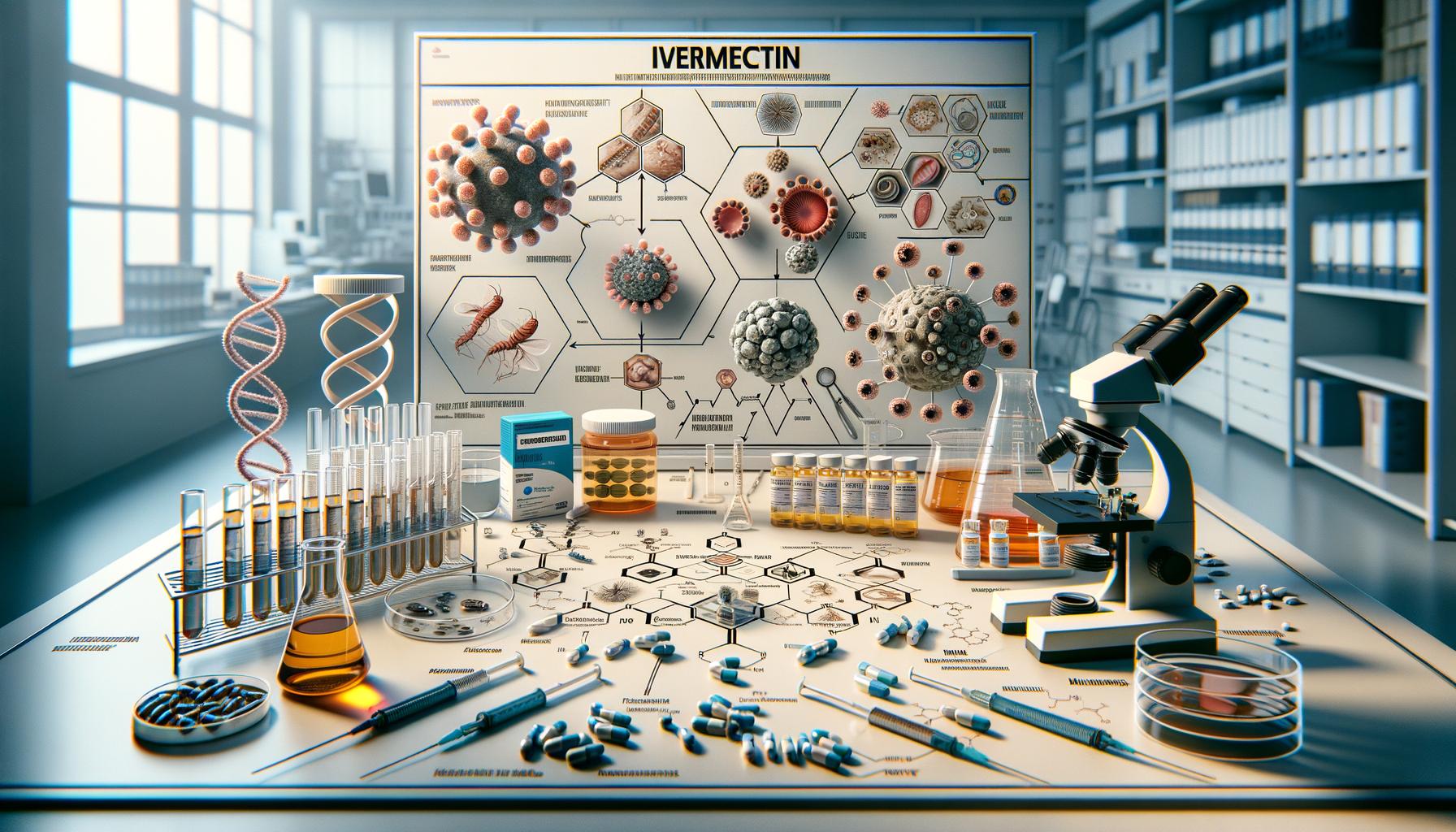Did you know that ivermectin, originally developed as an anti-parasitic medication, has intrigued researchers for its potential effects beyond its traditional use? Understanding the detailed mechanism of action (MOA) of ivermectin reveals how it interacts at the molecular level within biological systems, offering insights into its broad therapeutic effects. This knowledge is vital for anyone curious about how existing drugs can be repurposed or how specific biological actions translate into clinical outcomes.
Ivermectin works by interfering with key cellular processes-for instance, it can inhibit the transport of viral proteins into the cell nucleus by disrupting a protein complex called importin, which viruses like SARS-CoV-2 exploit to replicate. This multitargeted approach, supported by various lab studies and molecular simulations, helps explain why ivermectin remains a subject of scientific interest for infectious diseases and other conditions. While it’s essential to consider the limitations and ongoing research around its use, exploring ivermectin’s mechanism encourages informed decision-making and highlights the complexity behind drug actions. As you read on, you’ll gain a clear, scientifically grounded understanding of how ivermectin functions at a biological level, empowering you to engage more thoughtfully with medical information and discussions.
Ivermectin: An Overview of Its Importance in Medicine
Ivermectin has established itself as a cornerstone in modern medicine, particularly because of its broad spectrum of activity against a variety of parasitic infections. Originally developed as an anti-parasitic agent, it revolutionized the treatment of diseases caused by worms and other invertebrates, bringing hope and improved quality of life to millions, especially in resource-limited settings. Its appeal lies not only in its efficacy but also in its relative safety and ease of administration, making it accessible and practical for widespread use.
One of the critical reasons Ivermectin remains important today is its versatility. Beyond its primary use in combating parasites such as those causing onchocerciasis (river blindness) and strongyloidiasis, ongoing research explores its potential in other areas, including antiviral applications. While not a cure-all, this adaptability highlights the drug’s complex interaction with biological systems and opens avenues for repurposing in emerging health challenges. This reminds us how established medicines may harbor untapped potential, prompting scientific curiosity and careful investigation.
Patients and healthcare providers alike benefit from understanding that Ivermectin’s success comes with nuances. It is highly targeted, interfering specifically with pathways unique to parasites, which reduces side effects in humans. Still, it is crucial for individuals to consult healthcare professionals before use, as inappropriate administration can lead to adverse outcomes or ineffective treatment. Knowing when and how to use Ivermectin safely ensures that its benefits are maximized while minimizing risks.
- Widely used for parasitic infections: effective against various nematodes and ectoparasites.
- Potential antiviral properties: ongoing studies evaluate role beyond traditional uses.
- Accessible and relatively safe: suitable for mass drug administration programs.
- Requires medical guidance: to ensure appropriate dosing and avoid resistance.

Understanding Ivermectin’s Mechanism of Action
Ivermectin works by targeting the nervous system of parasites, a mechanism that explains both its potency and safety profile. It binds selectively to glutamate-gated chloride channels found in invertebrate nerve and muscle cells. This causes these channels to remain open, allowing chloride ions to flow into the cells. The resulting hyperpolarization effectively paralyzes the parasite by disrupting nerve signal transmission, leading to its death or inability to reproduce. Importantly, these specific channels do not exist in humans, which accounts for ivermectin’s relatively low toxicity when administered at recommended doses.
Beyond this classical antiparasitic action, ivermectin exhibits intriguing interactions with molecular pathways in viral infections. Studies suggest it can inhibit the transport of viral proteins into the host cell nucleus by disrupting the importin (IMP) α/β heterodimer complex. This nuclear import process is essential for the replication of some viruses. By interfering here, ivermectin potentially reduces viral replication, although this antiviral effect is still under investigation and should not be considered definitive treatment outside clinical trials.
Selective Targeting and Clinical Implications
- Parasitic specificity: Binding to glutamate-gated chloride channels only found in parasites reduces human side effects.
- Neurotransmission disruption: Causes paralysis in parasites, leading to their elimination.
- Antiviral potential: May inhibit viral protein trafficking mechanisms critical for virus propagation.
Due to its selective mechanism, ivermectin achieves effective parasite control with minimal impact on the host. However, this also means that incorrect dosing or use outside established indications can limit effectiveness or increase risks. Patients should always follow healthcare provider guidance to ensure safety and optimal outcomes. Understanding how ivermectin acts at the cellular level empowers better clinical decisions and highlights why ongoing research continues to explore new therapeutic angles for this multifaceted drug.
How Ivermectin Interacts with Biological Pathways
Ivermectin’s interaction with biological pathways extends beyond its well-known antiparasitic effects, revealing a fascinating complexity that supports its versatile use in medicine. At its core, ivermectin targets specific ion channels in parasites, but it also influences molecular transport systems critical for cellular function in various organisms. This dual action underlines why understanding these pathways is crucial for grasping ivermectin’s full therapeutic potential and limitations.
One key pathway ivermectin affects involves the importin (IMP) α/β heterodimer complex, a transport system responsible for shuttling proteins from the cytoplasm into the nucleus of cells. Some viruses rely heavily on this nuclear import to replicate by hijacking host cell machinery. Ivermectin disrupts this process by binding to and inhibiting the importin complex, thereby preventing viral proteins from entering the nucleus and replicating efficiently. This mechanism shows promise especially against RNA viruses such as SARS-CoV-2, though clinical evidence remains preliminary and requires careful interpretation[[[1]](https://pmc.ncbi.nlm.nih.gov/articles/PMC8526435/).
Beyond viral interactions, ivermectin’s affinity for various organic anion transporters demonstrates another layer of biological interplay. It has broad substrate specificity, capable of interacting with molecules like bile acids, steroids, and eicosanoids. These interactions may influence inflammation and immune responses, potentially contributing to ivermectin’s therapeutic effects in parasitic infections and beyond. However, these effects are subtle and complex, requiring more research to fully elucidate their clinical significance[[[2]](https://go.drugbank.com/drugs/DB00602).
Practical implications for patients and clinicians
- Targeted action: Ivermectin’s ability to selectively bind pathways unique to parasites and certain viruses supports safe use within defined doses.
- Multiple mechanisms: The drug’s interaction with nuclear transport and organic anion pathways suggests potential adjunct roles but also calls for caution in off-label use.
- Importance of medical guidance: Given ivermectin’s complex biological effects, professional consultation is essential to navigate benefits versus risks in diverse clinical scenarios.
Understanding ivermectin’s interaction with biological pathways equips users and healthcare providers with a more complete picture of how the drug operates within the body. It also showcases why ongoing scientific evaluation is vital, especially before extending uses outside established protocols. This knowledge empowers informed decisions that balance efficacy with safety, respecting both the promise and the limits of ivermectin’s biological activity.
Exploring Ivermectin’s Role Against Parasites
Ivermectin has transformed the treatment landscape for many parasitic infections, standing out due to its potent and selective action against a wide range of parasites. Its primary strength lies in its ability to disrupt key neural and muscular functions in parasites without significantly affecting human cells. This targeting hinges on ivermectin’s binding to glutamate-gated chloride channels, which are unique to invertebrates such as parasitic worms and insects. By opening these channels, ivermectin causes an influx of chloride ions, leading to hyperpolarization of nerve and muscle cells. The result is paralysis and death of the parasite, effectively clearing infections like strongyloidiasis, onchocerciasis (river blindness), and scabies[[[1]](https://www.drugs.com/ivermectin.html).
What sets ivermectin apart is its broad-spectrum efficacy. It targets both internal parasites, such as roundworms and whipworms, and external parasites like lice and mites. For example, in regions where river blindness is endemic, ivermectin mass administration has dramatically decreased disease prevalence, underscoring its public health significance. The drug’s selective toxicity ensures a favorable safety margin, but this still requires careful dosing and medical oversight to avoid rare but serious side effects[[[2]](https://www.webmd.com/drugs/what-is-ivermectin).
Considerations for Effective Use
- Dose timing: Some parasitic infections require repeated ivermectin doses, sometimes spaced months apart, due to life cycle variations of the parasites.
- Immune status impact: Individuals with compromised immune systems may need additional or adjusted dosing to fully eradicate parasites.
- Resistance monitoring: While ivermectin remains highly effective, emerging resistance in some parasite populations calls for ongoing surveillance and integrated control strategies.
Ivermectin’s parasiticidal power not only eases symptoms but also reduces the spread of parasitic diseases by breaking life cycle transmission. However, its use must be closely guided by healthcare professionals to tailor treatment to specific infections and patient needs. This approach optimizes benefits while minimizing risks and preserving ivermectin’s effectiveness for future generations.
The Impact of Ivermectin on Viral Infections
Ivermectin’s exploration beyond parasitic diseases has garnered attention due to its potential antiviral properties. Early laboratory research demonstrated that ivermectin can disrupt viral replication by interfering with the transport of viral proteins into the host cell nucleus. This process, known as importin alpha/beta-mediated nuclear import, is critical for the replication of several RNA viruses, including dengue, Zika, and notably SARS-CoV-2. By blocking this pathway, ivermectin may hinder the virus’s ability to hijack cellular machinery for reproduction, thereby slowing infection spread at the cellular level[[[2]](https://www.nature.com/articles/s41429-020-0336-z).
However, translating these in vitro findings to clinical effectiveness in humans is complex. Some in vitro studies have reported significant inhibition of SARS-CoV-2 replication at concentrations higher than those achievable with standard dosing regimens in patients[[[1]](https://www.mdpi.com/1424-8247/15/4/445). Clinical trials investigating ivermectin’s antiviral effects in COVID-19 have yielded mixed results. For instance, a carefully controlled study measuring viral loads found no significant difference between treated and placebo groups, suggesting that plasma concentrations required for antiviral action may not be reached safely in standard treatment scenarios[[3]](https://www.thelancet.com/journals/eclinm/article/PIIS2589-53702100239-X/fulltext).
Practical Considerations for Antiviral Use
- Mechanism complexity: Ivermectin’s antiviral effects depend on cellular pathways distinct from its antiparasitic activity, involving the inhibition of nuclear import processes critical for virus replication.
- Dosing challenges: Effective antiviral concentrations observed in lab studies are often higher than those safely achievable in patients, limiting clinical utility without adjusted formulations or delivery methods.
- Ongoing research: Clinical trials continue to explore if higher or alternative dosing, combination therapies, or novel delivery systems can safely harness ivermectin’s antiviral potentials.
In summary, while ivermectin exhibits intriguing antiviral mechanisms in laboratory settings, current clinical evidence does not strongly support its use as a standalone antiviral treatment. Its role remains primarily as a valuable antiparasitic. If considering ivermectin for viral infections, it is essential to consult healthcare professionals and rely on well-established, evidence-based treatments as the first line of defense. Continued research may clarify future applications or optimized regimens that safely leverage its antiviral properties.
Safety Profile: Common Side Effects and Risks
Ivermectin is generally well-tolerated when used appropriately, but like all medications, it carries a risk of side effects that patients and healthcare providers should be aware of. Its safety profile is well-characterized from decades of antiparasitic use worldwide, offering reassurance, yet vigilance remains important especially when considering off-label applications or higher doses. Understanding potential reactions helps set realistic expectations and informs timely responses if issues arise.
Most commonly, people may experience mild symptoms such as digestive upset, including nausea or diarrhea, along with dizziness or swelling. These side effects tend to be transient and resolve once the medication course is complete. Mild itching or rash can also occur but typically does not require intervention. These reactions often reflect the body’s response to dying parasites or immune system activation rather than direct drug toxicity.
Recognizing More Serious Reactions
Though rare, serious side effects need prompt medical attention. These may include:
- Severe skin reactions: Widespread rash, blistering, or signs of an allergic reaction such as swelling of the face or difficulty breathing.
- Neurological symptoms: Dizziness beyond mild lightheadedness, confusion, fainting, or irregular heartbeat.
- Swelling and pain: Particularly in joints or lymph nodes, which might indicate inflammatory responses.
Such effects may indicate hypersensitivity or complications linked to the immune response. Consulting a healthcare professional promptly ensures safe management.
Balancing Benefits and Risks
Ivermectin’s mechanism targets parasites with precision, limiting systemic effects, but individual sensitivity varies. Dosage, patient health status, and concurrent medications influence risk. For instance, those with liver impairment or pre-existing heart conditions might be more vulnerable. Importantly, side effects reported during investigations of ivermectin for viral infections sometimes relate to dosing beyond standard antiparasitic use, underlining the need for medical guidance.
| Common Side Effects | Serious Side Effects | When to Seek Help |
|---|---|---|
| Nausea, diarrhea, dizziness, mild rash, swelling | Severe rash, face swelling, irregular heartbeat, joint pain | If symptoms are severe, worsening, or impede daily activity |
Proactive communication with healthcare providers before and during ivermectin treatment is key. This is especially true when used in contexts outside approved indications, where evidence for safety and efficacy is still evolving.
Ultimately, ivermectin remains a valuable tool in medicine, especially for parasitic infections. Awareness of its safety profile allows patients and clinicians to use it judiciously, minimizing risks while harnessing its therapeutic benefits. Always consult qualified medical professionals for personalized advice tailored to your health history and treatment goals.
Comparative Efficacy: Ivermectin vs. Other Treatments
Ivermectin has carved out a niche primarily as a powerful antiparasitic agent with decades of proven success. However, when stacked against other treatment options-whether antiparasitic drugs, antivirals, or emerging therapies-its comparative efficacy depends heavily on the context of use. For parasitic infections like onchocerciasis and strongyloidiasis, ivermectin remains a gold standard, often preferred over older or less targeted drugs due to its potent mechanism and favorable safety profile.
When looking beyond parasitic diseases, particularly in viral infections such as COVID-19, ivermectin’s performance appears more nuanced. Clinical trials have demonstrated that ivermectin can reduce viral load significantly in patients with mild to moderate disease, but this has not consistently translated into better clinical outcomes compared with standard care or placebo groups. Meta-analyses of such trials underscore this point, revealing modest or inconclusive benefits relative to established antiviral or supportive treatments[[[1]](https://bmcinfectdis.biomedcentral.com/articles/10.1186/s12879-024-09563-y)[[[2]](https://pubmed.ncbi.nlm.nih.gov/38908535/).
Contextualizing Efficacy Across Treatment Options
- Antiparasitic comparisons: Drugs like albendazole and mebendazole are effective for intestinal worms but have narrower spectra or differing dosing requirements. Ivermectin’s broad activity, especially against ectoparasites and filarial worms, often provides a more streamlined treatment course.
- Antiviral comparisons: Unlike direct-acting antivirals targeting viral enzymes or processes specifically, ivermectin’s mechanism involves modulating host pathways that affect parasite or viral replication indirectly. This difference partly explains the variable clinical outcomes seen in viral infections.
- Safety and dosing considerations: Ivermectin’s once-daily dosing over a short span often favors adherence compared to multiple-dose regimens. However, doses used outside traditional antiparasitic indications may carry increased side effect risk, warranting careful risk-benefit analysis.
Practical Takeaways for Patients and Providers
For those facing parasitic infections, ivermectin’s efficacy is well-established, and choices about therapy mostly depend on parasite type and patient factors. When considering ivermectin for viral illnesses, emerging but equivocal evidence suggests it should not replace proven standard of care-treatment decisions must be guided by current clinical protocols and physician judgment.
| Condition | Ivermectin Efficacy | Comparative Treatments | Key Consideration |
|---|---|---|---|
| Onchocerciasis (river blindness) | Highly effective; reduces microfilariae load | Albendazole, doxycycline (supportive) | Single-dose, safe, well-tolerated |
| Strongyloidiasis | First-line therapy with strong efficacy | Albendazole (less effective) | Short-course treatment preferred |
| Mild to moderate COVID-19 | Reduces viral load; symptom improvement unclear | Antivirals (remdesivir, molnupiravir), supportive care | Not approved as standard; consult medical guidance |
Ultimately, ivermectin’s place in medicine thrives on its targeted biological action and broad antiparasitic use. While intriguing data suggests potential wider applications, treatment choices should always weigh evidence strength, safety, and individual patient needs. Open dialogue with healthcare professionals ensures informed, balanced decisions within evolving scientific landscapes.
Ivermectin Research: Key Studies and Findings
Ivermectin’s journey through scientific research is a tale of evolving understanding, from its origins as a potent antiparasitic to investigations into broader therapeutic potential. One key insight from recent studies reveals how ivermectin’s mechanism-primarily disrupting nervous system function in parasites by targeting glutamate-gated chloride channels-gives it a strong parasiticidal effect. This well-established action has been repeatedly confirmed in clinical settings, solidifying ivermectin’s role against onchocerciasis and strongyloidiasis with consistent efficacy and good safety profiles.
Interest expanded into viral infections, especially during the COVID-19 pandemic, sparking numerous clinical trials. Some randomized controlled studies showed ivermectin administered at relatively high doses (e.g., 24 mg daily for 5 days) led to significant reductions in viral load by Day 10 in mild to moderate COVID-19 patients[[[1]](https://bmcinfectdis.biomedcentral.com/articles/10.1186/s12879-024-09563-y). However, reductions in viral load did not consistently translate into improved clinical outcomes or symptom relief compared to placebo or standard care. This discrepancy suggests that while ivermectin might interfere with viral replication indirectly, it does not replace the targeted efficacy of approved antivirals against SARS-CoV-2.
Insights on Antiviral Potential and Limitations
- Laboratory findings: In vitro studies demonstrated that ivermectin can inhibit SARS-CoV-2 replication by a remarkable ~5000-fold reduction in viral RNA at 48 hours after a single dose in cell cultures[[[2]](https://www.sciencedirect.com/science/article/pii/S0166354220302011). This finding gave impetus to human trials but also highlighted a challenge-doses effective in vitro are often higher than those safely achievable in humans.
- Clinical trial variability: Human studies yielded mixed results, with some trials reporting viral load decrease but little to no effect on hospitalizations or symptom progression[[[1]](https://bmcinfectdis.biomedcentral.com/articles/10.1186/s12879-024-09563-y). Meta-analyses tend to conclude the evidence is insufficient to broadly recommend ivermectin for COVID-19 outside of clinical research settings.
- Mechanistic considerations: Unlike direct antivirals that target viral proteins or enzymes, ivermectin’s action may involve modulation of host cell pathways that indirectly affect viral replication. This nuanced mechanism likely explains its variable efficacy and underscores why standard antiviral drugs are generally preferred.
Practical Takeaways from Research Findings
For patients and providers, the scientific consensus supports ivermectin’s strong role in antiparasitic therapy-especially for filarial infections and intestinal parasites-where its mechanism and efficacy are clear-cut. Conversely, using ivermectin for viral infections remains experimental, with current data advising caution. It’s essential to follow established therapeutic guidelines and engage healthcare professionals before considering ivermectin beyond its approved uses.
The evolving research landscape invites ongoing studies into dosage optimization, resistance patterns, and potential combination therapies that could better harness ivermectin’s properties. Meanwhile, understanding both its proven benefits and known limitations empowers informed healthcare decisions grounded in evidence, safety, and patient-centered care.
| Study Type | Focus | Key Findings | Clinical Implications |
|---|---|---|---|
| Randomized Controlled Trials | COVID-19 patients with mild to moderate disease | Significant viral load reduction by day 10; no clear symptom improvement | Not recommended as standard COVID-19 treatment; supportive, not definitive |
| In Vitro Laboratory Studies | SARS-CoV-2 viral replication | ~5000-fold reduction in viral RNA at 48 hours post-dose | Proof of concept; high doses needed challenge clinical translation |
| Meta-analyses & Reviews | Various viral and parasitic indications | Confirms strong antiparasitic efficacy; inconclusive antiviral benefit | Supports continued use for parasitic diseases; cautious on antivirals |
Real-World Applications: Clinical Use Cases
Ivermectin’s proven effectiveness in treating parasitic infections has made it a staple in clinical practice worldwide. Its ability to selectively target glutamate-gated chloride channels in parasites leads to paralysis and death of harmful organisms without significant effects on human cells. This unique action underpins its widespread use against onchocerciasis (river blindness), strongyloidiasis, and scabies, offering patients relief with generally well-tolerated dosing regimens. Physicians often rely on ivermectin in endemic areas where these infections pose significant health burdens, improving quality of life and reducing disease transmission through mass drug administration programs.
Outside its classical applications, ivermectin’s interaction with host and pathogen biological pathways has inspired off-label explorations, though such uses require caution. For instance, ivermectin has been trialed as a potential adjunct therapy during viral infections like COVID-19, reflecting a scientific curiosity about its ability to modulate cellular transport proteins and immune responses. However, clinical evidence has so far not supported routine use for viral illnesses due to inconsistent outcomes and safety concerns at higher doses. Patients and providers should prioritize evidence-based guidelines and discuss risks transparently before considering ivermectin beyond its approved indications.
Practical Considerations in Clinical Settings
- Dosing adherence: Correct dosing is critical, particularly because ivermectin’s antiparasitic mechanisms depend on sustained exposure to disrupt parasite nerve function effectively. Clinicians must tailor regimens based on infection type, patient weight, and comorbidities to maximize efficacy and minimize side effects.
- Monitoring and Resistance: While ivermectin shows robust parasite clearance, vigilance for emerging resistance is vital. Resistance has been documented in veterinary use and occasionally in human pathogens, emphasizing the importance of integrated treatment approaches and ongoing surveillance.
- Patient counseling: Clear communication about what ivermectin can and cannot do helps set realistic expectations. Educating patients on potential mild side effects, such as dizziness or gastrointestinal discomfort, supports adherence and timely reporting of adverse reactions.
Real-world cases highlight ivermectin’s success in mass drug administration campaigns, where large populations receive treatment to break parasitic life cycles and prevent outbreaks. These interventions showcase the drug’s public health impact beyond individual therapy, contributing to sustainable control or elimination of neglected tropical diseases. When used appropriately, ivermectin exemplifies how understanding a drug’s detailed mechanism of action translates into effective, practical medical solutions.
| Clinical Scenario | Use of Ivermectin | Outcome | Key Notes |
|---|---|---|---|
| Onchocerciasis endemic regions | Mass drug administration (150 µg/kg annually) | Reduced microfilariae load; transmission control | Requires repeated yearly doses; excellent community tolerance |
| Strongyloidiasis treatment | Single or multiple doses based on infection severity | High cure rates; symptom resolution | Important in immunocompromised patients; monitor for hyperinfection |
| Off-label viral infection studies | Experimental high-dose regimens | Mixed viral load reduction; limited clinical benefit | Not recommended outside clinical trials; safety monitoring critical |
Understanding Resistance to Ivermectin in Pathogens
Ivermectin resistance is an emerging challenge that deserves careful attention, especially as the drug remains a cornerstone for controlling many parasitic diseases globally. Resistance occurs when parasites adapt to the drug’s effects, reducing ivermectin’s ability to disrupt their nervous systems effectively. While well-documented mainly in veterinary parasites, there is growing concern about resistance spreading in human pathogens, threatening long-term treatment success.
Several biological mechanisms underlie this resistance. One key factor involves the enhanced activity of efflux pumps-proteins that remove the drug from parasite cells before it can exert its effect. In particular, P-glycoproteins (P-gp), a type of membrane transporter, have been implicated in pumping ivermectin out of parasitic cells, reducing drug accumulation and efficacy. For example, studies on the sheep parasite Haemonchus contortus have demonstrated that increased expression of P-glycoprotein genes correlates with ivermectin resistance, indicating this as a crucial defensive adaptation by parasites [2].
Beyond drug efflux, changes in the parasite’s nervous system can also contribute. Since ivermectin targets glutamate-gated chloride channels to paralyze parasites, mutations or altered expression of these channels can make parasites less vulnerable. Additionally, transcriptomic analyses reveal that neuronal plasticity-the parasite’s ability to alter nerve function and connectivity-may help worms survive despite ivermectin exposure [1].
Practical Considerations to Address Resistance
- Integrated treatment strategies: Combining ivermectin with other antiparasitic agents can lower the chances parasites develop resistance by attacking them through multiple pathways.
- Monitoring and surveillance: Systematic assessment of parasite populations for genetic markers of resistance enables early detection and timely adjustments in treatment protocols.
- Optimized dosing: Ensuring correct dosing regimens-neither too low to enable survival nor too high to increase side effects-helps maintain drug efficacy and reduce resistance selection pressure.
- Education and stewardship: Health professionals and communities must understand the importance of adhering to prescribed treatments and avoiding unnecessary or incorrect ivermectin use that can accelerate resistance.
Resistance in ectoparasites such as ticks also relates to similar mechanisms, including upregulated ABC transporter genes involved in detoxification and drug efflux. Field studies of tick populations exposed to ivermectin have shown significant increases in these gene expressions, reinforcing the role of efflux systems in multi-resistant parasitic species [3].
| Resistance Mechanism | Description | Implications for Treatment |
|---|---|---|
| P-glycoprotein-mediated efflux | Parasites pump ivermectin out of cells, reducing intracellular drug levels | May require higher doses or combination therapies to overcome drug expulsion |
| Glutamate-gated chloride channel mutations | Altered drug targets reduce ivermectin binding and paralysis effect | Decreased drug sensitivity; need for alternative drugs or targets |
| Neuronal plasticity | Parasites adjust nervous system function to tolerate drug exposure | Complicates treatment effectiveness; highlights necessity for research |
| Upregulation of ABC transporter genes | Increased detoxification and drug removal from parasite cells | Leads to multidrug resistance; calls for integrated vector management |
As resistance grows, medical and veterinary communities must collaborate to develop innovative solutions while preserving ivermectin’s valuable role. Consulting with healthcare providers before altering or extending ivermectin use is essential, as resistance management benefits from well-informed, evidence-based decisions. Maintaining balance between effective parasite control and stewardship safeguards ivermectin’s benefits for future generations.
Future Prospects: Innovations in Ivermectin Research
Ivermectin continues to inspire innovative research aimed at overcoming its current limitations and expanding its therapeutic potential. Scientists are increasingly focusing on understanding the molecular mechanisms that govern drug resistance, especially concerning how parasites evade treatment. Novel approaches seek to modulate or inhibit key resistance factors like P-glycoproteins-proteins that act as drug pumps expelling ivermectin from parasite cells-thereby restoring drug sensitivity. By targeting these transporters directly or co-administering inhibitors, future therapies may enhance ivermectin’s effectiveness even against resistant strains.
Advancements in genetic and molecular biology tools also open new doors to tailor treatments. For example, recent studies utilizing genome editing and transcriptome analysis are unraveling how specific mutations in glutamate-gated chloride channels and neuronal plasticity pathways alter parasite susceptibility. This detailed insight paves the way for designing next-generation molecules that bind more efficiently or target alternative sites, minimizing the risk of cross-resistance. Additionally, research into combinations of ivermectin with complementary antiparasitic agents is promising, providing multi-pronged attacks that reduce the emergence of resistance.
Innovative Delivery Systems and Formulations
Improving how ivermectin is delivered also forms a critical research frontier. Scientists are developing novel formulations-such as sustained-release injectables, nanoparticles, and transdermal patches-that could maintain stable drug levels over longer periods. These innovations help optimize dosing schedules, reduce side effects, and improve patient compliance, particularly in remote or resource-limited settings. Enhanced delivery systems can also allow precise targeting of parasites in specific tissues, refining therapeutic action and lowering systemic exposure.
- Drug resistance modulation: Identifying inhibitors to block efflux pumps like P-glycoproteins may restore ivermectin sensitivity.
- Precision targeting: Exploring new molecular targets within parasite nervous systems to bypass resistance mutations.
- Combination therapies: Strategically pairing ivermectin with other agents to disrupt parasite survival across multiple pathways.
- Advanced formulations: Designing controlled-release and targeted delivery systems for improved efficacy and convenience.
By staying grounded in rigorous scientific evaluation, ongoing research balances optimism with caution. Ivermectin’s proven safety and utility make it a valuable template for innovation, but all new strategies require thorough clinical validation. Health providers and patients should maintain open dialogue and consult experts before considering experimental uses. Ultimately, the advances in understanding ivermectin’s mechanism and resistance will guide smarter, more durable antiparasitic therapies that protect global health for years to come.
Faq
Q: How does ivermectin affect chloride ion channels in parasites?
A: Ivermectin binds to glutamate-gated chloride ion channels in parasites, increasing chloride ion influx. This hyperpolarizes nerve and muscle cells, causing paralysis and death of the parasite. Understanding this specific ion channel modulation is crucial for grasping ivermectin’s targeted antiparasitic biological action.Q: Why does ivermectin show selective toxicity towards parasites and not human cells?
A: Ivermectin selectively targets parasite-specific glutamate-gated chloride channels absent in humans, leading to minimal effects on human cells. This selective binding explains its safety and efficacy, as it exploits biological differences between parasites and hosts.
Q: What role does ivermectin play in modulating host immune responses?
A: Besides direct parasite killing, ivermectin may modulate the host’s immune system by reducing inflammation and cytokine release. This immunomodulatory effect supports its broader biological action and is an emerging area for further clinical research.
Q: How does ivermectin interfere with viral replication mechanisms?
A: Ivermectin inhibits importin α/β-mediated nuclear transport, blocking viral proteins from entering the host cell nucleus. This interrupts viral replication cycles, suggesting a mechanism beyond antiparasitic activity, though clinical effectiveness requires further validation.
Q: Can ivermectin’s mechanism help overcome resistance in parasites?
A: Resistance arises when parasites alter their chloride channels or efflux ivermectin. Understanding ivermectin’s precise MOA guides development of strategies such as drug combinations to counteract resistance and maintain therapeutic efficacy.
Q: What molecular pathways are influenced by ivermectin in nematodes?
A: In nematodes, ivermectin modulates neurotransmission by binding glutamate-gated chloride channels, disrupting neural and muscle activity. This leads to paralysis and expulsion. Targeting these molecular pathways highlights ivermectin’s specific biological mechanism in parasitic nematodes.
Q: How does ivermectin’s lipophilicity impact its biological action?
A: Ivermectin is highly lipophilic, enabling it to cross parasite membranes easily and reach target chloride channels. This chemical property enhances its bioavailability and potency, contributing to its efficient mechanism of action.
Q: What are the implications of ivermectin binding affinity variations among parasite species?
A: Variations in ivermectin’s binding affinity to chloride channels across species affect drug sensitivity and efficacy. Recognizing these differences aids in optimizing dose regimens and developing species-specific antiparasitic treatments.
For deeper insights on ivermectin’s mechanism and biological activity, explore your main article sections and consult healthcare professionals for personalized guidance.
Closing Remarks
Understanding ivermectin’s detailed mechanism of action reveals its precision in targeting parasite-specific channels, making it a powerful anthelmintic and insecticide. This insight not only highlights its biological role but also forms the foundation for ongoing research into its broader therapeutic potentials. If you’re keen to dive deeper into how ivermectin works or explore related treatments and drug mechanisms, our comprehensive resources are here to guide you.
Don’t miss out-subscribe to our newsletter for the latest updates in pharmacology and parasite control, or explore our expert articles on antiviral and antimalarial agents. Your journey to mastering ivermectin’s mode of action and its biomedical significance starts with informed exploration. Feel free to share your thoughts, ask questions, or suggest topics to keep this conversation going. Together, let’s build a trusted knowledge base that helps you make confident, science-backed decisions.






